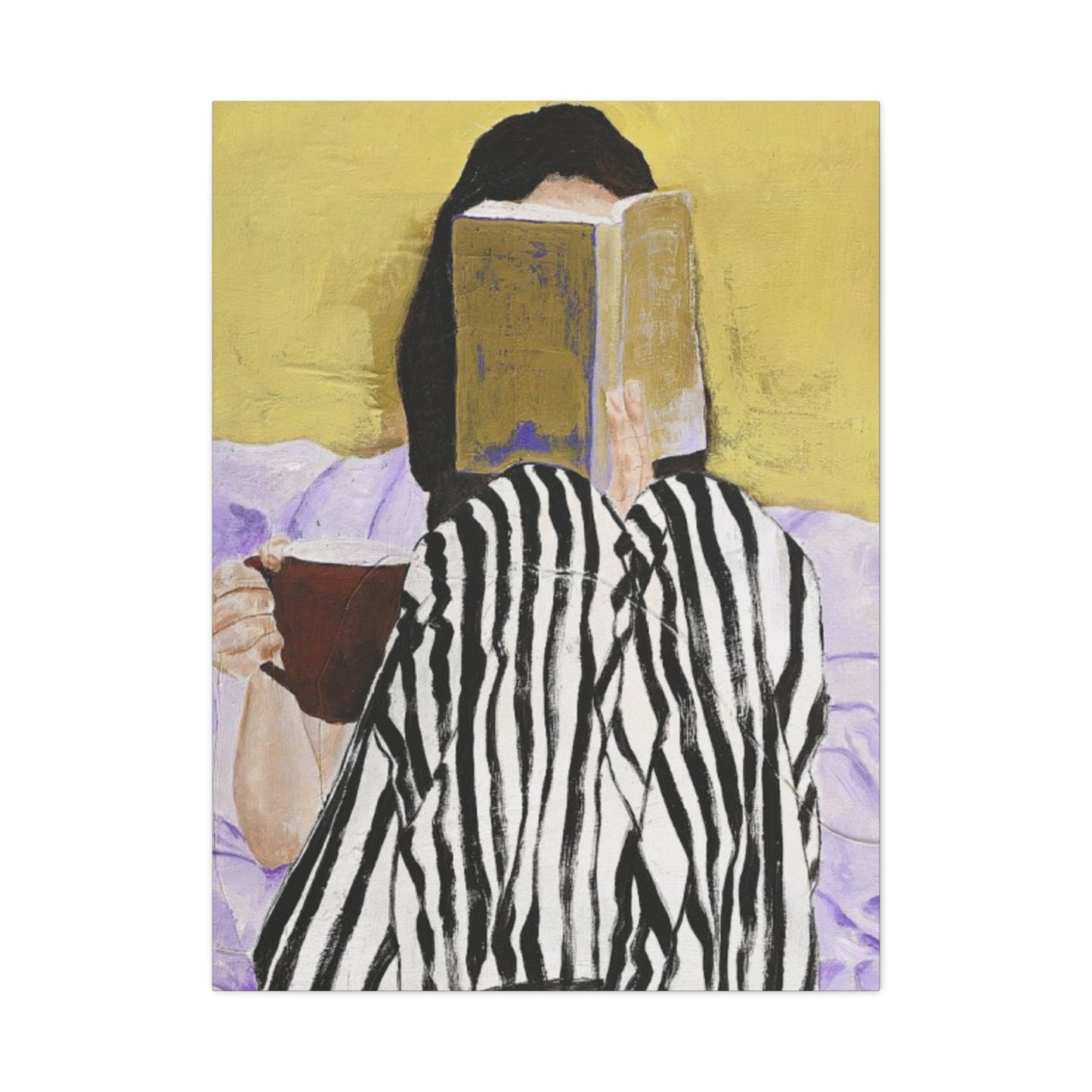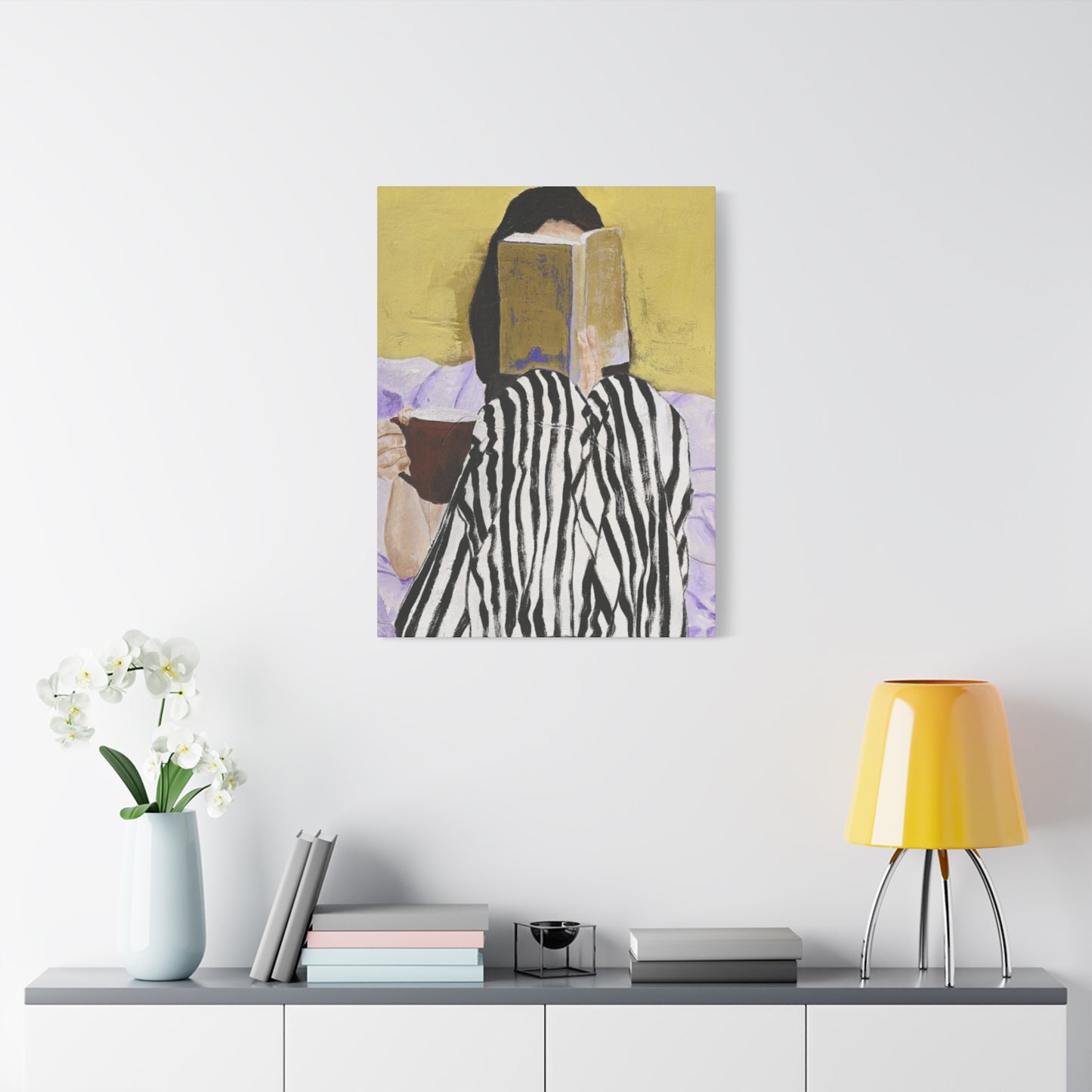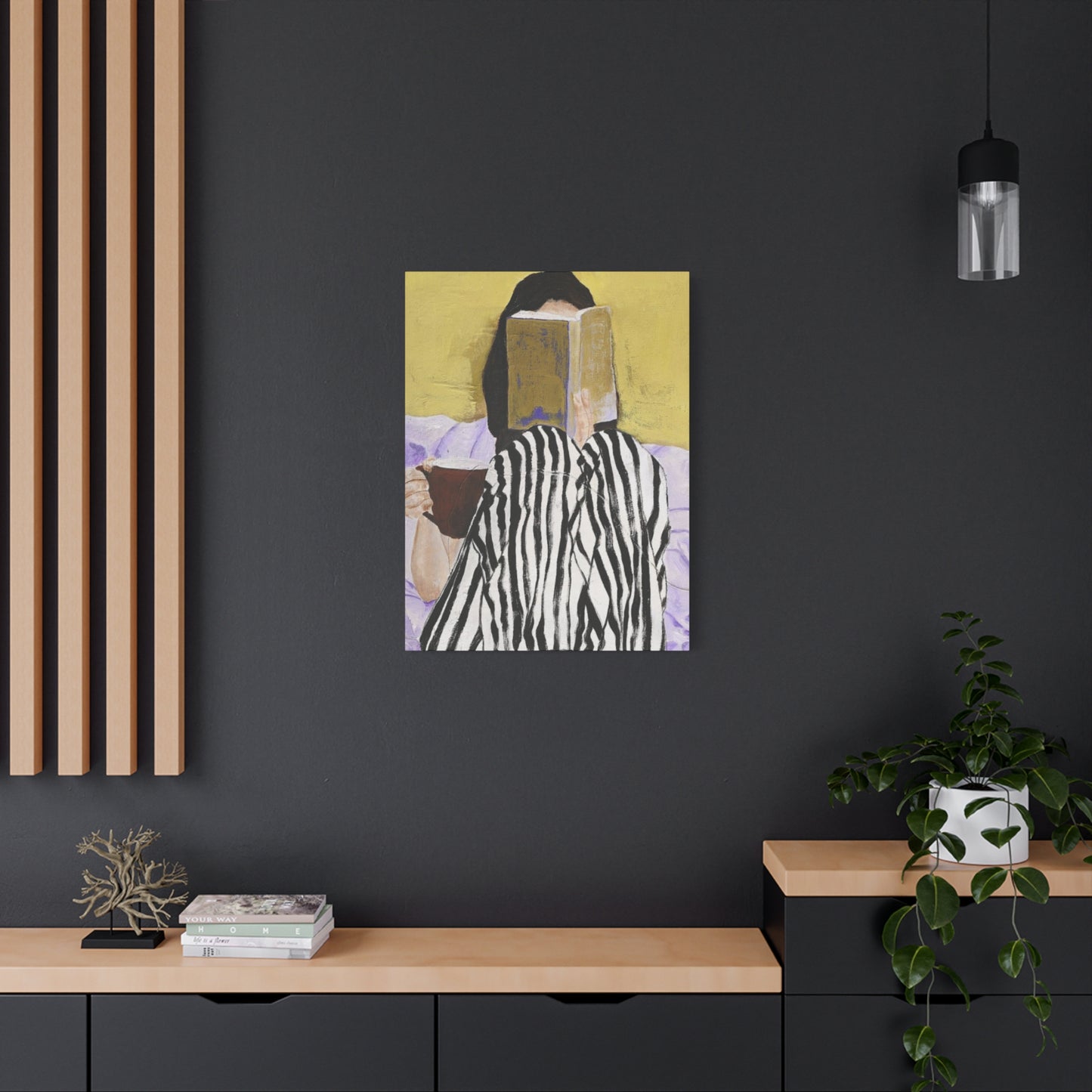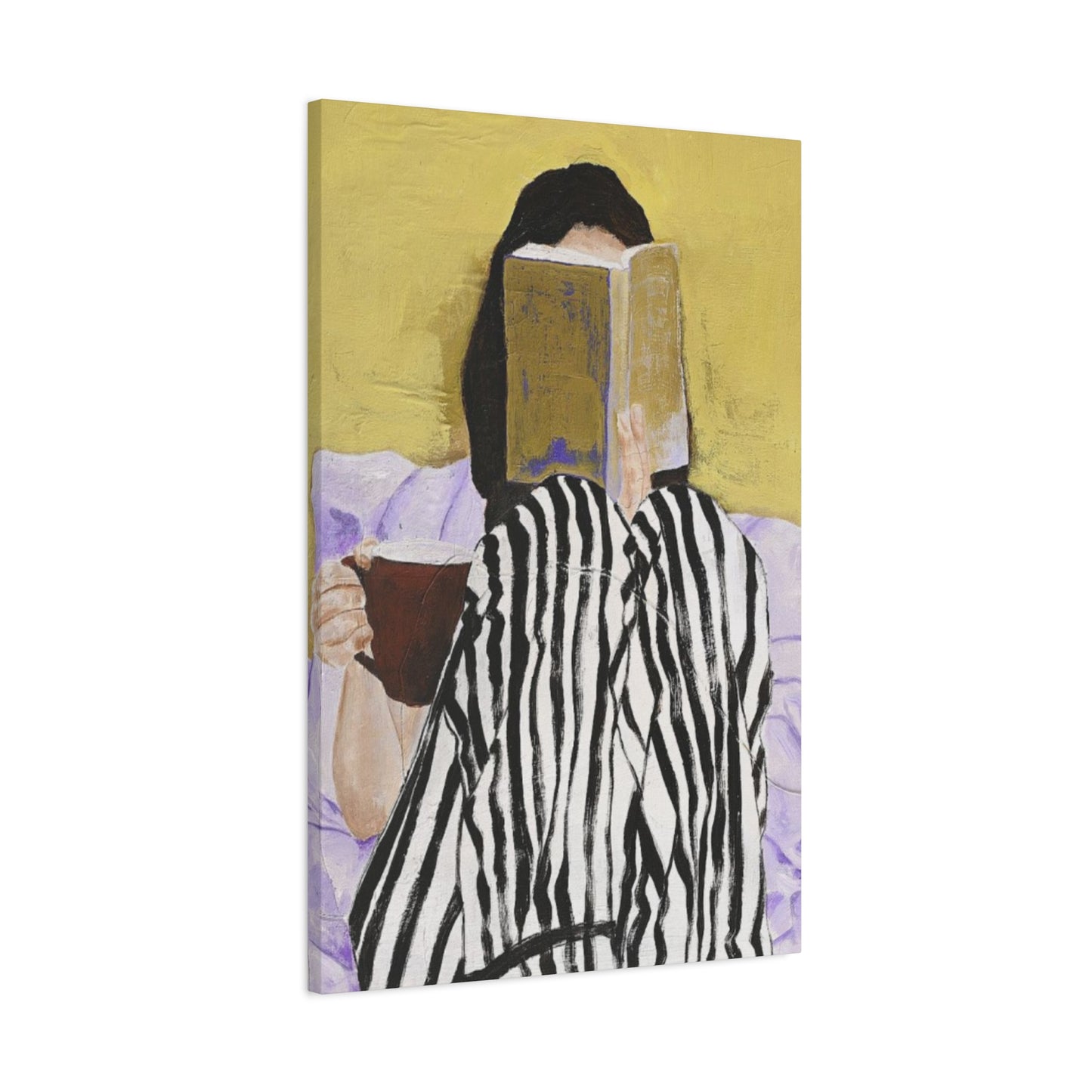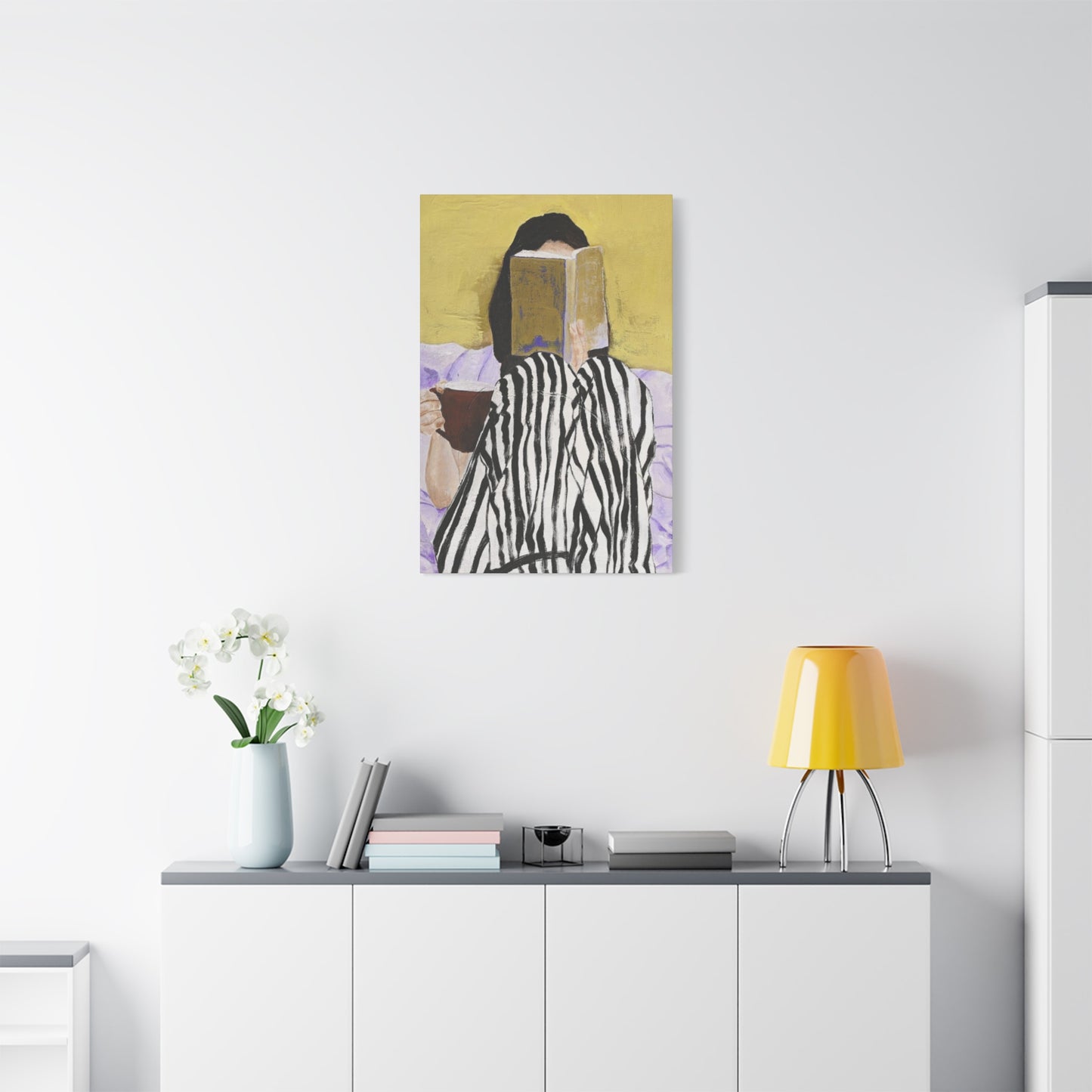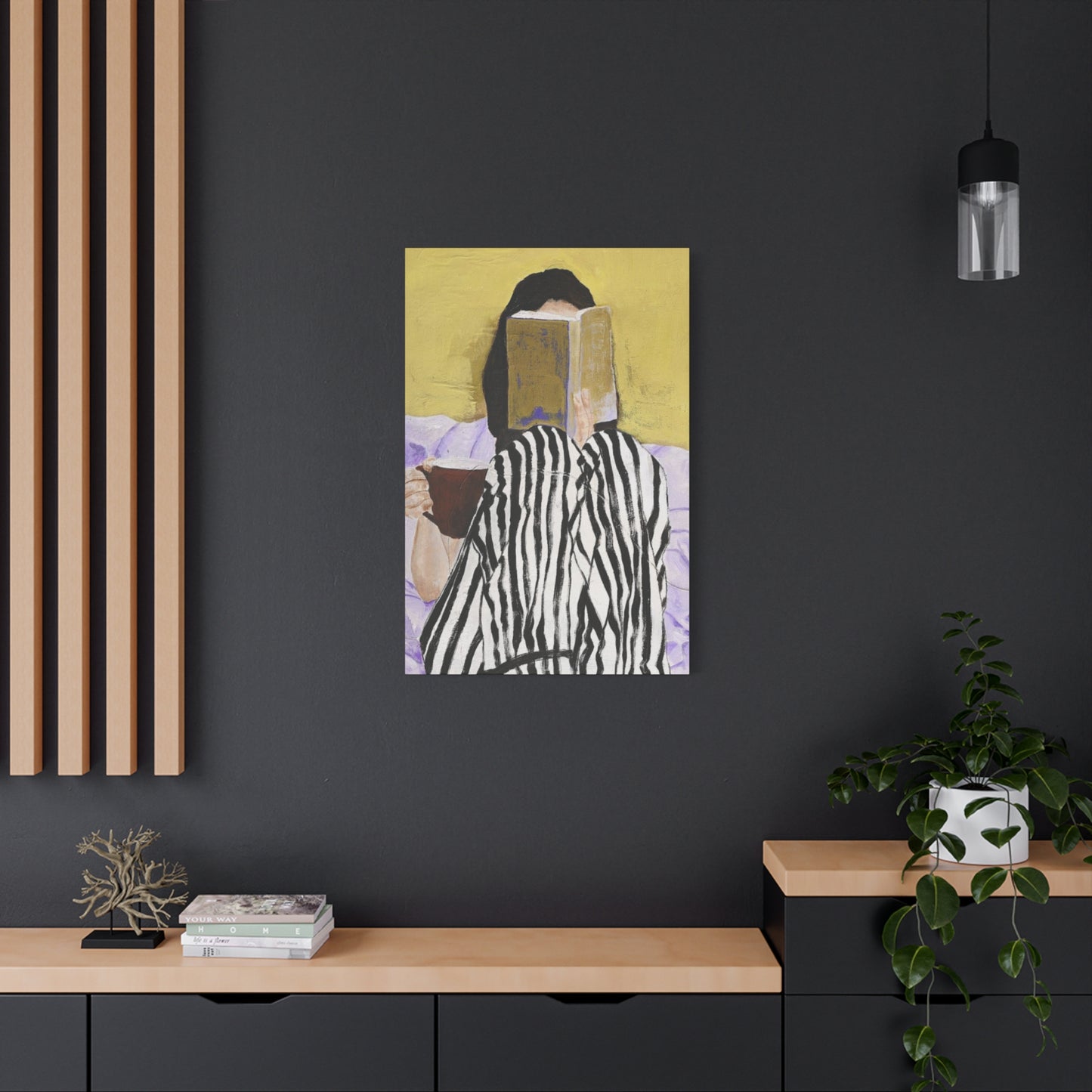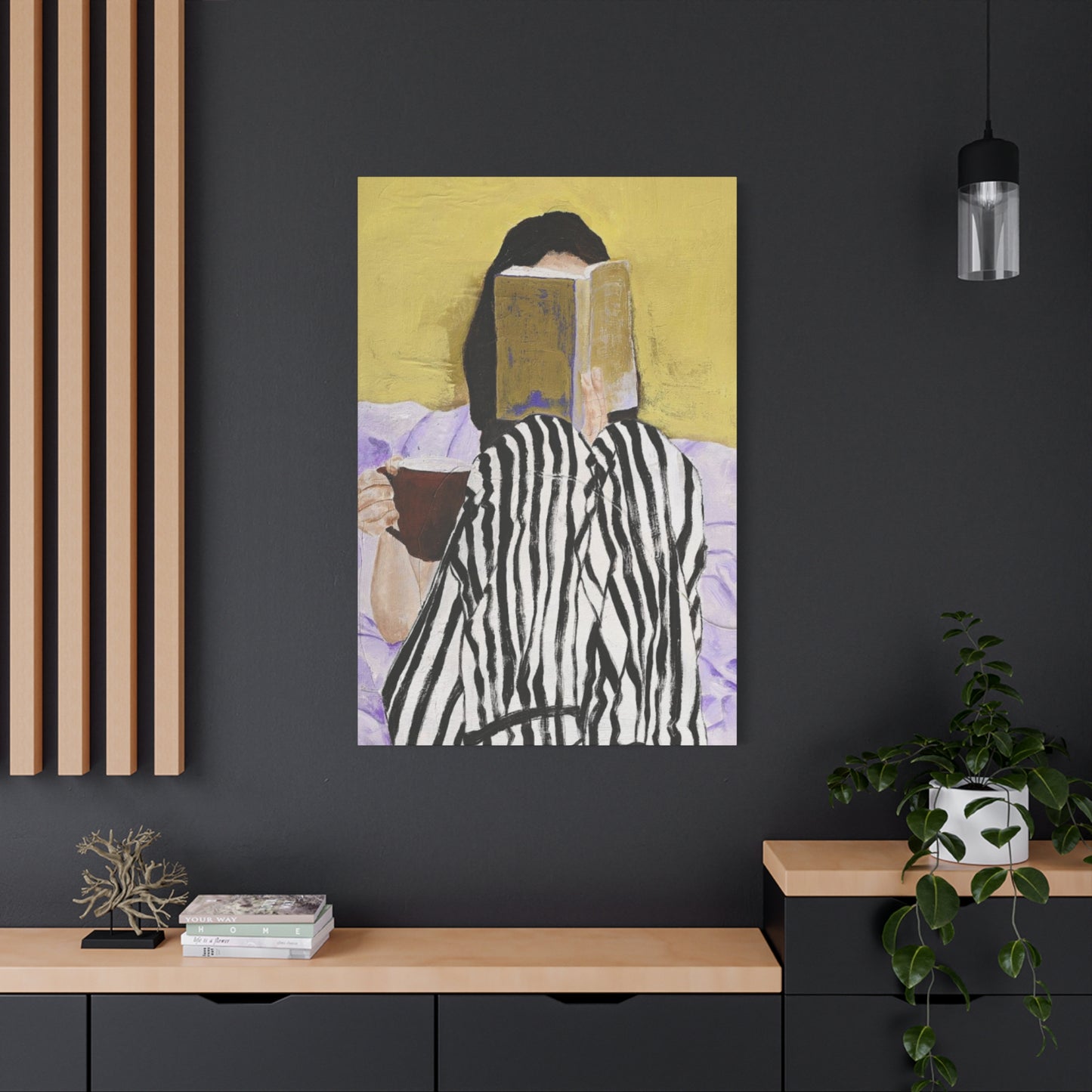The Intersection of Literature and Art: Reading Book Modernism Wall Art Explained
The fusion of literature, femininity, and modern art has given rise to a captivating genre of home decoration known as Reading Book Modernism wall art. This style beautifully captures the intellectual and aesthetic worlds through canvas prints that depict women immersed in books. Far beyond simple decoration, these artworks represent a profound cultural appreciation for knowledge, contemplation, and the timeless elegance associated with readers lost in the pages of literary worlds.At the heart of this artistic movement is the celebration of the reader—particularly female readers—who symbolize curiosity, introspection, and empowerment. Historically, reading has been a gateway to intellectual freedom and self-discovery, and modernist art has long explored themes of identity, perception, and experience. By combining these elements,
Reading Book Modernism wall art creates a visual dialogue that honors both literary culture and the evolving role of women as thinkers and creators.The imagery in this genre often features stylized, minimalist depictions of women holding or engaging with books, set against backgrounds that range from abstract shapes to subtle muted tones. This modernist approach strips away unnecessary details to focus on form, posture, and expression, allowing viewers to connect emotionally with the serenity and concentration of the readers portrayed. The artworks invite contemplation, encouraging onlookers to reflect on their own relationship with literature and the power of ideas.
In interior design, these pieces serve as more than just wall decor; they transform living spaces into intellectual sanctuaries. Whether placed in reading nooks, home libraries, offices, or bedrooms, Reading Book Modernism prints set a tone of sophistication and thoughtful calm. Their presence signals a space where knowledge is valued and creativity is nurtured.Contemporary artists contributing to this genre are diverse in style but united in theme. Many draw inspiration from literary greats, feminist ideals, and modernist art pioneers, blending classical influences with fresh, contemporary aesthetics. The result is artwork that feels both timeless and relevant, bridging past and present cultural conversations.
For homeowners, incorporating this type of wall art offers a way to personalize spaces with meaning. It speaks to those who cherish books, intellectual growth, and the quiet power of reading. Furthermore, these pieces harmonize well with minimalist, Scandinavian, and mid-century modern decor styles, thanks to their clean lines and thoughtful compositions.In conclusion, Reading Book Modernism wall art represents a compelling intersection of literature, femininity, and modern artistic expression. It elevates home decoration into a celebration of intellectual curiosity and aesthetic beauty, creating environments that inspire and reflect the enduring power of the written word.
The Evolution of Women Reading as an Artistic Subject Throughout History
The portrayal of female readers in visual arts has undergone remarkable transformation across centuries. During the Renaissance period, depictions of women with books often carried religious significance, showing saints or the Virgin Mary engaged with sacred texts. As society progressed through the Enlightenment and into modern eras, these representations shifted to reflect changing attitudes toward female literacy and education. By the nineteenth century, artists began capturing intimate moments of women absorbed in secular reading, reflecting the growing accessibility of literature to broader audiences.
The modernist movement of the early twentieth century brought revolutionary changes to how artists approached this subject matter. Rather than focusing solely on realistic representation, modernist painters explored abstract forms, bold colors, and psychological depth in their portraits of reading women. This artistic evolution mirrored societal transformations as women gained increased access to education, literature, and intellectual discourse. Contemporary canvas art continues this tradition while incorporating elements of minimalism, digital techniques, and diverse cultural perspectives that make these pieces relevant for today's interior spaces.
Understanding this historical context enriches appreciation for modern interpretations of women reading on canvas. Each piece connects to a broader narrative about feminine intellectual empowerment, the democratization of knowledge, and the universal human experience of losing oneself in a compelling story. When selecting wall art featuring female readers, homeowners participate in this ongoing cultural conversation while creating visually stunning focal points for their living spaces.
Defining Characteristics of Feminine Modernism in Contemporary Canvas Art
Feminine modernism in canvas art represents a distinctive aesthetic approach that combines clean lines, thoughtful composition, and emotional resonance. This style emphasizes the inner life of subjects rather than external details, often using simplified forms and strategic color palettes to convey mood and atmosphere. When applied to portraits of women engaged with literature, feminine modernism creates artwork that feels both timeless and thoroughly contemporary, suitable for diverse interior design schemes while maintaining artistic integrity.
The color choices in feminine modernist pieces typically favor sophisticated neutrals punctuated by strategic accent colors. Soft beiges, warm grays, muted blues, and gentle blush tones create harmonious compositions that complement modern home aesthetics without overwhelming other design elements. These restrained palettes allow the subject matter to remain focal while ensuring the artwork integrates seamlessly with existing furnishings and architectural features. The careful balance between visual interest and aesthetic restraint distinguishes quality feminine modernist work from more generic decorative pieces.
Composition in feminine modernist canvas art often employs negative space deliberately, allowing breathing room around the central figure to enhance contemplative qualities. Artists working in this style understand that what remains unshown can be as powerful as what appears on the canvas. This approach particularly suits depictions of reading women, where the act of reading itself represents internal focus and intellectual engagement. The surrounding emptiness on the canvas mirrors the psychological space readers occupy when absorbed in books, creating a visual metaphor that resonates with book lovers who understand this unique state of consciousness.
How Canvas Prints of Women Reading Transform Home Library Spaces
Home libraries and reading nooks benefit tremendously from thoughtfully selected wall art that reinforces the space's purpose while enhancing its aesthetic appeal. Canvas prints featuring female readers create immediate thematic resonance in these areas, visually communicating the room's function while inspiring occupants to engage with their own literary collections. Unlike generic artwork, these subject-specific pieces establish an atmosphere of intellectual engagement and quiet contemplation that aligns perfectly with the activities these spaces accommodate.
The scale of canvas prints matters significantly in library settings. Larger pieces can serve as commanding focal points above reading chairs or across from bookshelves, while smaller works might be grouped in gallery arrangements to create visual interest across expansive wall surfaces. When selecting sizes, consider the viewing distance and surrounding elements. A substantial canvas positioned where it can be appreciated from across the room creates different impact than an intimate piece meant for close viewing in a cozy reading corner. Both approaches have merit depending on the specific spatial characteristics and desired atmosphere.
Lighting considerations play a crucial role in how canvas art performs within library spaces. Natural light can beautifully illuminate these pieces during daytime hours, but artificial lighting options should be planned carefully to prevent glare while ensuring the artwork remains visible during evening reading sessions. Picture lights, adjustable track lighting, or strategically positioned floor lamps can highlight canvas prints effectively without creating reflective hotspots that diminish viewing quality. The interplay between the artwork, books, and lighting creates a cohesive environment that celebrates literature in both written and visual forms.
Selecting the Perfect Canvas Art for Different Interior Design Styles
Matching canvas art featuring reading women to various interior design aesthetics requires understanding both the artwork's characteristics and the design principles of different styles. Scandinavian interiors, known for their minimalist sensibility and natural materials, pair beautifully with feminine modernist pieces that feature clean lines and neutral palettes. The simplicity inherent in both the design style and the artwork creates harmonious spaces that feel calm and uncluttered while maintaining visual interest through carefully chosen focal pieces.
Traditional and transitional interiors offer different opportunities for incorporating contemporary canvas art. These spaces often blend classical elements with modern touches, creating eclectic environments where thoughtful art selection bridges temporal boundaries. Canvas prints with slightly more detailed rendering or incorporating subtle vintage elements can complement traditional furnishings without appearing anachronistic. The key lies in identifying pieces that honor classical portraiture traditions while incorporating enough contemporary styling to feel fresh and relevant within the overall design scheme.
Industrial and modern loft spaces provide dramatic backdrops for bold canvas art featuring women immersed in literature. These environments typically feature exposed brick, concrete surfaces, and metal elements that create textural contrast against the softness of canvas prints. In such settings, artwork can either harmonize with the industrial aesthetic through muted tones and simplified compositions, or provide deliberate contrast through warmer colors and more detailed representations. Both approaches work effectively depending on whether the goal is cohesive integration or dynamic visual tension that energizes the space.
The Psychology Behind Why Book Lovers Connect With Reading-Themed Wall Art
The emotional and psychological connections people form with artwork depicting reading scenes run deeper than simple aesthetic appreciation. For dedicated readers, these images resonate on a profoundly personal level, reflecting back their own experiences of literary immersion and intellectual exploration. Seeing representations of reading women in their daily environment serves as both validation of their priorities and gentle encouragement to carve out time for this meaningful activity. This psychological reinforcement creates spaces that not only look beautiful but actively support residents' values and lifestyle choices.
Canvas art featuring contemplative female readers also taps into universal human needs for quiet reflection and mental space. In increasingly hectic contemporary life, visual reminders of calm, focused activities provide psychological anchoring. These images function as visual prompts suggesting that pausing, reflecting, and engaging deeply with ideas remains not only acceptable but valuable. The mere presence of such artwork can subtly influence inhabitants' behavior patterns, encouraging them to slow down and engage more meaningfully with their surroundings and activities.
From a social perspective, displaying reading-themed wall art communicates aspects of identity to visitors and household members alike. These pieces signal intellectual curiosity, appreciation for arts and culture, and values prioritizing knowledge and personal growth. For many homeowners, particularly those who identify strongly as readers, this form of self-expression through decor choices feels more authentic than generic decorative options. The artwork becomes part of how they present themselves to the world, creating environments that truly reflect who they are and what matters to them beyond superficial design trends.
Purchasing Canvas Prints for Long-Term Display
Quality canvas prints require attention to several technical specifications that determine both immediate visual impact and long-term durability. The canvas material itself varies considerably across products, with museum-grade cotton canvas offering superior longevity compared to synthetic alternatives. Cotton canvas provides better color retention, resists yellowing, and develops an attractive patina over time rather than degrading noticeably. While synthetic options may cost less initially, the investment in quality materials pays dividends through extended lifespan and maintained visual appeal.
Printing technology significantly affects final results in canvas artwork. Giclée printing, which uses archival-quality inks and high-resolution digital printing processes, produces exceptional color accuracy and detail preservation. These prints can last decades without significant fading when properly cared for, making them suitable for heirloom-quality art collections. Lower-quality printing methods may produce acceptable initial results but often show deterioration within just a few years, particularly when exposed to natural light. Verifying printing methods before purchase ensures realistic expectations about how the artwork will perform over time.
Stretching and framing techniques also impact both aesthetics and preservation. Gallery-wrapped canvases, where the image continues around the edges of the stretcher bars, create contemporary presentations suitable for hanging without additional framing. This approach works particularly well with minimalist and modern interiors where simplicity is paramount. Alternatively, canvas prints can be mounted in traditional frames that add protective elements while creating visual boundaries that suit more formal spaces. The depth of stretcher bars affects how substantially the canvas projects from the wall, with deeper profiles creating more dramatic shadows and physical presence.
Creating Gallery Wall Arrangements With Multiple Canvas Pieces
Gallery walls featuring multiple canvas prints allow for creative expression while building visual complexity through thoughtful arrangement. When working with reading-themed artwork, curating a collection that maintains thematic consistency while introducing variety prevents monotony. This might involve selecting pieces that depict different reading poses, vary color palettes within a cohesive range, or incorporate different artistic styles that share common elements. The goal is creating conversation between pieces rather than simple repetition.
Planning gallery wall layouts benefits from preliminary floor arrangements before committing to wall placement. Laying out canvases on the floor allows experimentation with spacing, alignment, and composition without creating unnecessary wall damage. Common approaches include grid arrangements that emphasize order and symmetry, salon-style hangings that embrace controlled asymmetry, or linear arrangements that work well in hallways or above furniture pieces. Each organizational principle creates different visual effects and suits particular architectural contexts better than others.
Spacing between individual canvases significantly affects how the gallery wall reads as a unified installation versus a collection of separate pieces. Closer spacing, typically two to three inches between frames, encourages viewers to perceive the arrangement as a single artistic statement. Wider spacing allows each piece more independence while still contributing to the overall composition. Consistency in spacing creates polish and intentionality, preventing the haphazard appearance that undermines even well-chosen individual pieces. Using paper templates or painter's tape to mark positions before hanging ensures precision in execution.
The Role of Color Theory in Selecting Reading-Themed Canvas Art
Understanding basic color theory principles enables more strategic artwork selection that enhances rather than conflicts with existing interior palettes. Complementary color schemes, which pair colors opposite each other on the color wheel, create vibrant, energetic compositions that draw attention and energize spaces. However, for areas intended for reading and contemplation, analogous color schemes using adjacent wheel positions often prove more suitable, creating harmony and visual rest that supports the space's calming purpose.
Temperature considerations in color selection affect perceived ambiance significantly. Warm colors including reds, oranges, and yellows create cozy, inviting atmospheres that work beautifully in personal reading spaces and intimate home libraries. These hues psychologically suggest comfort and security, encouraging occupants to settle in with books for extended periods. Cool colors like blues, greens, and purples introduce tranquility and mental clarity, making them excellent choices for studies or reading areas where focus and concentration take priority over pure comfort.
Neutral-based canvas art offers versatility that appeals to homeowners who anticipate evolving their interior design over time. Pieces predominantly featuring grays, beiges, taupes, and whites integrate easily with changing accent colors and design trends without requiring replacement. This practical consideration balances against the reality that more colorful artwork can create stronger emotional responses and more distinctive visual statements. The ideal solution often involves selecting primarily neutral pieces while incorporating one or two more colorful canvases that can be rotated or replaced as tastes evolve.
Incorporating Vintage Literary Aesthetics Into Modern Canvas Designs
The romance of vintage literary culture translates beautifully into contemporary canvas art through careful aesthetic borrowing and reinterpretation. Elements like antique book covers, classic typography, vintage eyeglasses, and period clothing details can be incorporated into modern compositions that honor literary history while maintaining contemporary relevance. This fusion creates pieces that appeal to both nostalgia and current design sensibilities, making them particularly popular among readers who appreciate both classic literature and modern living spaces.
Sepia tones and aged color palettes evoke historical periods without requiring literal vintage reproduction. Modern canvas prints can employ these coloring techniques to suggest timelessness while benefiting from contemporary printing quality and artistic approaches. This strategy works especially well when the goal is creating cohesive aesthetics in homes featuring mixed vintage and modern furnishings. The artwork becomes a bridge element that helps disparate pieces feel intentionally curated rather than accidentally assembled.
Combining vintage literary elements with distinctly modern compositional approaches creates intriguing visual tension that sophisticated viewers appreciate. A female reader might be portrayed in period dress while the surrounding space receives abstract treatment, or contemporary clothing might be paired with vintage book styling. These juxtapositions acknowledge both historical literary traditions and current cultural contexts, resulting in artwork that stimulates thought while serving decorative functions. The most successful pieces in this hybrid category maintain balance, ensuring neither vintage nor modern elements overwhelm the composition.
Understanding Different Artistic Styles in Contemporary Female Reader Portraits
Representational realism in canvas art featuring reading women offers detailed, lifelike portrayals that emphasize technical skill and observational accuracy. These pieces often showcase intricate details in facial expressions, hand positions, and book textures that create tangible presence. Viewers can almost imagine themselves in the depicted scene, making these works particularly immersive. Realist approaches work exceptionally well in traditional interiors and spaces where classical art appreciation guides aesthetic choices.
Impressionistic treatments bring softer, more atmospheric qualities to reading portraits. Rather than crisp details, impressionist-influenced pieces emphasize mood, lighting effects, and emotional resonance through looser brushwork and emphasis on color relationships. These works capture the feeling of reading moments rather than photographic accuracy, often resulting in dreamier, more romantic presentations. Impressionistic canvas art particularly suits spaces intended for relaxation and escape, where harder-edged realism might feel too literal or demanding.
Abstract and semi-abstract approaches deconstruct the reading figure into shapes, colors, and gestural marks that suggest rather than explicitly depict the subject. These pieces require more viewer participation in completing the image mentally, creating interactive viewing experiences that reveal new details over time. Abstract reading-themed artwork introduces intellectual engagement beyond the literary reference itself, appealing to collectors who appreciate conceptual complexity in their decorative choices. Such pieces work beautifully in contemporary spaces where artistic experimentation and non-traditional aesthetics are valued.
Sizing Guidelines for Canvas Art in Various Room Configurations
Proper scale relationships between canvas art and surrounding spaces determine whether pieces enhance or overwhelm their environments. In living rooms and large open spaces, substantial canvases measuring forty-eight inches or larger in at least one dimension create appropriate visual weight without disappearing against expansive walls. These statement pieces work particularly well above sofas, mantels, or in dedicated art walls where they receive adequate viewing distance. Undersized artwork in large spaces creates tentative, unfinished impressions that diminish overall design cohesion.
Bedrooms and personal reading spaces often accommodate medium-sized canvases ranging from twenty-four to forty inches in their largest dimension. These proportions maintain presence without dominating intimate spaces where comfort and relaxation take precedence over dramatic visual impact. Positioning matters significantly in smaller rooms, with artwork placed at eye level when seated often proving more appropriate than standard standing eye level. This adjustment ensures optimal viewing angles for spaces primarily experienced while relaxing rather than actively moving through them.
Hallways, staircases, and transitional spaces benefit from vertical canvas orientations that complement architectural proportions. These areas typically feature narrow wall expanses where horizontal pieces would either be uncomfortably small or extend beyond available space. Vertical reading portraits, particularly those emphasizing standing or seated figures in tall compositions, naturally suit these configurations. Series of smaller vertical pieces can also be arranged in ascending or descending sequences that guide movement through the space while maintaining thematic consistency.
The Environmental Impact of Canvas Print Production and Sustainable Alternatives
Conscientious consumers increasingly consider environmental implications when purchasing home decor, including canvas wall art. Traditional canvas print production involves several potentially concerning elements including cotton cultivation, chemical treatments, printing inks, and packaging materials. Conventional cotton farming consumes substantial water and often relies on pesticides, while some canvas treatments and inks contain volatile organic compounds that affect air quality. Understanding these impacts allows for more informed purchasing decisions aligned with environmental values.
Sustainable canvas options increasingly appear in the marketplace as manufacturers respond to consumer demand for eco-friendly products. Organic cotton canvas eliminates pesticide concerns while often requiring less water in cultivation. Bamboo and hemp alternatives offer renewable, fast-growing fiber sources with minimal agricultural inputs. These materials perform comparably to conventional cotton while significantly reducing environmental footprints. Some manufacturers also utilize recycled canvas, giving new life to materials that would otherwise contribute to waste streams.
Printing technology choices significantly affect environmental profiles of finished pieces. Water-based inks eliminate many toxic compounds found in solvent-based alternatives while producing comparable or superior color quality. Some cutting-edge printing operations have achieved carbon-neutral status through renewable energy use and offset programs. Packaging represents another opportunity for environmental consideration, with minimal, recyclable, or compostable materials preferable to excessive plastic and foam. Seeking out producers who prioritize these factors allows art purchases to align with broader sustainability commitments.
Ensure Decades of Beautiful Display
Proper maintenance extends canvas print lifespan significantly while preserving color vibrancy and structural integrity. Regular dusting using soft, dry cloths or dedicated art dusters prevents particle accumulation that can gradually abrade canvas surfaces or attract moisture. Cleaning should always proceed gently, using light strokes that move with the canvas weave rather than against it. Avoid feather dusters, which can snag on canvas texture, and never use wet cleaning methods unless specifically recommended by the manufacturer for particular pieces.
Placement decisions profoundly affect long-term preservation of canvas artwork. Direct sunlight causes inevitable fading over time, even with archival-quality inks and materials. Positioning canvases away from windows or using UV-filtering glass in frames provides protection without sacrificing display opportunities. Similarly, placement near heat sources like radiators or fireplaces accelerates deterioration through thermal stress and humidity fluctuations. Climate-controlled environments with moderate, stable temperature and humidity levels preserve canvas art optimally.
Periodic professional evaluation and conservation ensures valuable pieces receive expert care beyond routine home maintenance. Art conservators can identify developing issues before they become severe, perform specialized cleaning, repair minor damage, and recommend improved display conditions. For heirloom-quality artwork or pieces with significant financial or sentimental value, establishing relationships with conservation professionals provides peace of mind and helps protect investments. Even less expensive prints benefit from basic conservation principles, extending their useful life and maintaining visual quality.
How Reading-Themed Canvas Art Supports Literacy and Educational Values in Homes
Displaying artwork that celebrates reading creates subtle but meaningful educational messaging within home environments, particularly for households with children. Visual reinforcement of reading as a valued, enjoyable activity helps cultivate literacy-positive attitudes without direct instruction. Young people absorbing these environmental messages internalize that reading matters to their family and deserves dedicated time and attention. This ambient educational approach complements direct literacy instruction and parental modeling of reading behaviors.
Conversation opportunities naturally arise around thoughtfully selected canvas art, allowing parents and caregivers to discuss not just the artwork itself but broader themes of literature, learning, and intellectual curiosity. A canvas depicting a woman absorbed in a book might prompt discussions about favorite stories, the importance of education, or how reading expands understanding of the world and different perspectives. These organic teaching moments integrate seamlessly into daily life rather than feeling like formal lessons, potentially increasing receptivity and retention.
Book-themed wall art also helps define spaces within homes as learning environments rather than purely recreational areas. This spatial designation matters psychologically, particularly in open-plan homes where distinct functional zones might otherwise blur together. A reading nook or home library clearly identified through thematic artwork becomes a recognized place for intellectual engagement, potentially increasing its use for educational purposes. Environmental design that supports learning goals represents an often-overlooked aspect of creating successful educational spaces within residential settings.
The Investment Potential of Original Canvas Art Versus Print Reproductions
Understanding distinctions between original canvas paintings and print reproductions helps buyers make informed decisions aligned with their priorities, budgets, and intentions. Original works represent unique creations by individual artists, typically commanding significantly higher prices due to their singularity, the artist's time investment, and art market dynamics. These pieces may appreciate in value, particularly if the artist gains recognition, making them potential financial investments beyond their decorative function. However, originals require substantial upfront investment and involve market uncertainties.
Limited edition prints occupy middle ground between mass-produced reproductions and one-of-a-kind originals. These pieces, produced in defined quantities often numbered and signed by artists, maintain some exclusivity while remaining more accessible than originals. Collectors value limited editions for their relative scarcity, and certain editions from recognized artists do appreciate over time. The balance between affordability and collectibility makes limited edition canvas prints attractive to buyers seeking artwork with potential lasting value without original painting price points.
Mass-produced print reproductions offer maximum accessibility and affordability, allowing widespread appreciation of artwork that would otherwise remain unavailable to most consumers. These pieces serve primarily decorative rather than investment functions, with minimal resale value but immediate visual impact. For homeowners prioritizing aesthetics over financial considerations, high-quality reproductions provide excellent value. They allow design flexibility, enabling periodic refreshment of interior aesthetics without significant financial commitment. Understanding these distinctions prevents mismatched expectations between what different product categories offer.
Regional and Cultural Variations in Depicting Women Readers Across Canvas Art
Artistic representations of women engaged with books vary significantly across cultural contexts, reflecting different societal attitudes toward female literacy, education, and public versus private reading spaces. Western European and North American artistic traditions have long featured women readers in domestic interiors, emphasizing private contemplation and leisure reading. These compositions typically showcase comfortable furnishings, good lighting, and solitary figures, reflecting cultural values around individual intellectual pursuits and personal space.
Middle Eastern and Asian artistic traditions offer different perspectives on women and reading, often emphasizing communal learning, religious study, or specific educational contexts. Contemporary canvas art drawing from these traditions might depict women reading in gardens, courtyards, or alongside family members, reflecting cultural emphases on collective rather than purely individual intellectual development. These variations provide valuable alternatives to dominant Western imagery, allowing homeowners to select artwork that better reflects their own cultural backgrounds or desired aesthetic diversity.
Contemporary global artistic exchanges increasingly blend traditional regional approaches with international modernist influences, creating hybrid styles that honor cultural specificity while embracing universal themes. A canvas piece might combine Japanese compositional principles with Western figure treatment, or incorporate African textile patterns into otherwise European-style portraits. These cross-cultural syntheses produce visually exciting artwork that acknowledges our interconnected world while celebrating distinct artistic heritages. Collectors seeking unique pieces that transcend purely regional categorization find rich opportunities in this globally influenced contemporary canvas art.
Commissioning Custom Canvas Art Featuring Personal Reading Moments
Custom commissioned artwork allows for deeply personalized pieces that capture specific individuals, favorite books, or meaningful reading locations rather than generic representations. Working with artists to create custom canvas pieces begins with clear communication about desired subjects, artistic styles, sizing requirements, and intended display locations. Providing reference photographs, color preferences, and examples of admired existing artwork helps artists understand client visions and expectations, increasing likelihood of satisfactory results.
The commissioning process typically progresses through several stages including initial consultations, preliminary sketches, refinement based on feedback, and final execution. Timeline expectations should be realistic, acknowledging that quality custom artwork requires substantial time for proper development and execution. Rush orders may incur premium charges or compromise quality as artists compress necessary creative processes. Planning commissioned pieces well in advance of intended gift-giving or room completion dates prevents unnecessary pressure on both parties.
Investment in custom artwork generally exceeds purchasing existing pieces, reflecting the additional time, skill, and personalization involved. However, the resulting unique creations often carry greater emotional value and personal significance than mass-produced alternatives. Custom pieces become family heirlooms, capturing specific life moments, beloved individuals, or treasured literary connections in ways generic artwork cannot. For significant life events, milestone celebrations, or creating truly distinctive interiors, commissioned canvas art offers incomparable value despite higher monetary costs.
Integrating Digital Art Technologies Into Canvas Print Production
Advanced digital technologies have revolutionized canvas print production, expanding possibilities for artistic expression while improving accessibility and affordability. Digital painting and illustration software enables artists to create works specifically designed for canvas reproduction, with full control over final output characteristics. These digital-native pieces can incorporate effects, layering techniques, and color manipulations difficult or impossible in traditional media, resulting in distinctive contemporary aesthetics particularly suited to modern interiors.
Hybrid approaches combining traditional art creation with digital enhancement represent increasingly common production methods. Artists might create initial paintings or drawings using conventional materials, then scan and digitally refine them, adjusting colors, removing imperfections, or adding elements. This workflow preserves the organic qualities of hand-created art while leveraging digital precision and flexibility. The resulting canvas prints benefit from both approaches, maintaining artistic authenticity while achieving technical excellence.
Augmented reality technologies are beginning to influence how consumers select and visualize canvas art before purchase. Applications allowing virtual placement of artwork images within photographed rooms help buyers confidently assess sizing, color compatibility, and overall aesthetic fit. Some platforms even simulate different lighting conditions to demonstrate how pieces will appear throughout the day. These technologies reduce purchase uncertainty, potentially decreasing returns while increasing customer satisfaction by ensuring better matches between selected artwork and intended display environments.
The Therapeutic Benefits of Surrounding Yourself With Literary-Themed Art
Environmental psychology research demonstrates that surroundings significantly influence mood, stress levels, and overall wellbeing. Thoughtfully selected artwork contributes to therapeutic home environments that support mental health and emotional balance. Canvas prints depicting peaceful reading scenes specifically promote calmness through subject matter that inherently suggests tranquility, focus, and escape from immediate stressors. These visual cues trigger associations with the relaxing, restorative experiences many people have with reading itself, extending those benefits through constant environmental presence.
Color psychology within canvas art amplifies therapeutic potential when selections align with desired emotional effects. Soft blues and greens in reading-themed artwork promote tranquility and reduce anxiety, making them excellent choices for bedrooms or meditation spaces. Warmer earth tones create comfort and security, suitable for family areas and personal retreats. Even in the absence of deliberate color therapy knowledge, most individuals instinctively recognize which hues make them feel calm, energized, or comfortable, allowing intuitive selection of therapeutically appropriate artwork.
The representation of solitude and quiet contemplation in reading-themed canvas art provides visual permission for viewers to prioritize similar activities in their own lives. Modern culture often glorifies constant productivity and social connectivity, potentially creating guilt around taking time for solitary pursuits. Artwork normalizing and celebrating quiet reading offers counterbalance to these pressures, reminding inhabitants that withdrawal for reading, thinking, and recharging represents healthy, valuable behavior. This environmental messaging supports mental health by validating necessary self-care practices.
Exploring Minimalist Approaches to Women Reading Canvas Art
Minimalist aesthetics in canvas art featuring female readers emphasize essential elements while eliminating decorative excess, creating powerful statements through restraint rather than abundance. These pieces typically employ limited color palettes, simple compositions, and generous negative space that focuses attention on core subjects. A minimalist reading portrait might reduce the figure to essential shapes and lines, suggest rather than detail the book, and surround the subject with empty canvas that emphasizes isolation and concentration characteristic of reading experiences.
The appeal of minimalist reading-themed artwork lies partly in its versatility across interior design contexts. These understated pieces integrate seamlessly with both minimalist spaces, where they reinforce existing aesthetic principles, and more traditionally decorated rooms, where they provide contemporary contrast without stylistic conflict. This adaptability makes minimalist canvas art particularly valuable for homeowners who anticipate evolving their interior design over time or who occupy rental properties where permanent architectural modifications are impractical.
Creating effective minimalist canvas art requires exceptional artistic skill, as simplified forms must communicate clearly without supportive detail. The artist's understanding of essential characteristics that make figures recognizable, convey emotion, and establish narrative becomes crucial when decorative elements are stripped away. High-quality minimalist pieces demonstrate masterful economy, where every remaining element carries significant communicative weight. This efficiency of expression appeals to viewers who appreciate intellectual rigor and artistic discipline, making minimalist reading-themed canvas art particularly suitable for contemporary collectors with modernist sensibilities.
Building Cohesive Interior Narratives Through Thematically Linked Artwork
Developing cohesive interior narratives through intentional artwork selection creates homes that tell stories about inhabitants' interests, values, and aesthetic sensibilities. Reading-themed canvas art serves as an excellent anchor for broader literary narratives that might extend across multiple rooms or throughout entire homes. This thematic approach transforms individual art pieces from isolated decorative elements into connected chapters of a larger environmental story that reveals itself gradually as visitors move through spaces.
Supporting elements beyond primary canvas artwork reinforce literary themes while adding depth to the overall narrative. Vintage books displayed as decorative objects, reading lamps with distinctive character, comfortable seating arrangements positioned for optimal reading comfort, and even literary quotes incorporated into architectural elements work synergistically with canvas art. This multi-layered approach creates immersive environments where every element contributes to unified themes, resulting in spaces with strong identity and memorable character.
Balancing thematic consistency with visual variety prevents spaces from becoming monotonous despite focused narratives. While all artwork might relate to books and reading, variations in artistic style, color palette, scale, and specific subject interpretation maintain visual interest. One room might feature contemplative portraits of solitary readers while another showcases more energetic depictions of book clubs or public reading spaces. This approach preserves thematic unity while preventing repetitive visual experiences that could diminish impact through over-familiarity.
The Social Aspects of Collecting and Displaying Reading-Themed Canvas Art
Art collecting, even at accessible price points, creates opportunities for social connection with fellow enthusiasts who share similar interests and aesthetic values. Online communities, local art fairs, gallery openings, and collector groups facilitate interactions where members discuss favorite pieces, share acquisition stories, and exchange information about artists and emerging trends. For those drawn to reading-themed canvas art, these social circles often overlap with book clubs and literary communities, creating rich networks of like-minded individuals united by appreciation for both visual and written arts.
Displaying collected artwork generates natural conversation topics when hosting visitors, allowing homeowners to share enthusiasm about specific pieces, artists, or broader collection themes. Unlike more generic decor that rarely inspires discussion, distinctive canvas art featuring women reading often prompts questions about acquisition stories, artistic techniques, or the collector's relationship with reading and literature. These conversations deepen social interactions beyond superficial small talk, potentially fostering more meaningful connections between hosts and guests.
Social media platforms have amplified the social dimensions of art collecting and display, with dedicated accounts, hashtags, and communities focused on home art curation. Sharing images of newly acquired canvas pieces, completed gallery walls, or redesigned spaces incorporating reading-themed artwork generates engagement from global audiences with shared interests. This digital dimension of collecting extends beyond local geographic constraints, connecting enthusiasts across continents while inspiring and informing ongoing collection development. The intersection of visual art appreciation, literary culture, and interior design creates particularly active online communities where ideas and enthusiasm circulate freely.
Seasonal Rotation Strategies for Canvas Art Collections
Developing rotation strategies for canvas art collections maintains visual freshness while preventing habituation that diminishes appreciation of individual pieces. Seasonal rotations align artwork with changing light conditions, color palettes, and atmospheric qualities of different times of year. Lighter, airier reading-themed pieces featuring bright backgrounds and outdoor settings might display during spring and summer months, while warmer, more intimate portrayals of women reading by firelight or under cozy blankets suit autumn and winter seasons.
Practical considerations for art rotation include proper storage of non-displayed pieces to prevent damage during off periods. Climate-controlled storage areas protect canvas from temperature extremes and humidity fluctuations that accelerate deterioration. Canvas pieces should be stored vertically when possible rather than stacked horizontally, which can stress stretcher bars and damage surfaces. Protective coverings preventing dust accumulation without trapping moisture help maintain condition, ensuring rotated pieces return to display in excellent state.
Rotation schedules need not follow strict seasonal patterns if other organizational principles better suit collectors' preferences. Thematic rotations might coordinate with reading challenges, book club selections, or literary events. Color-based rotations could support evolving interior color schemes as homeowners experiment with different palettes throughout the year. The key advantage of rotation systems lies not in specific scheduling approaches but in the refreshed perspective and renewed appreciation that comes from periodically experiencing familiar pieces after temporary absence.
Conclusion:
The enduring fascination with artwork depicting women immersed in books reflects fundamental human appreciation for intellectual pursuit, quiet contemplation, and the transformative power of literature. Contemporary canvas prints capturing these moments bridge historical artistic traditions and modern aesthetic sensibilities, creating pieces that feel simultaneously timeless and thoroughly current. For homeowners who value both visual beauty and intellectual substance, this genre of wall art offers rare opportunities to express identity while enhancing living spaces with meaningful decoration.
The versatility of reading-themed canvas art ensures relevance across diverse interior design contexts, from minimalist modern apartments to traditional family homes rich with architectural detail. Whether selecting representational realism, impressionistic interpretations, or abstract explorations of the reading experience, collectors find abundant options matching their specific aesthetic preferences and existing decor. This breadth of available styles democratizes access to quality artwork, allowing enthusiasts at various price points and taste profiles to participate in curating personalized collections.
Technical advances in printing technology, materials science, and digital art creation have expanded possibilities for canvas art production while improving quality and accessibility. Today's consumers benefit from unprecedented choice in both subject matter and execution quality, with options ranging from affordable mass-produced prints to investment-grade limited editions and commissioned original works. Understanding distinctions between these categories empowers informed purchasing decisions aligned with individual priorities, whether emphasizing budget consciousness, environmental sustainability, or long-term investment potential.
The psychological and emotional dimensions of surrounding oneself with images celebrating reading extend beyond mere decoration into realms of identity expression, value communication, and environmental support for desired behaviors. Homes featuring thoughtfully selected reading-themed artwork become spaces that actively encourage intellectual engagement, model priorities for younger household members, and create atmospheres conducive to contemplation and learning. These functional benefits complement aesthetic contributions, making such artwork valuable on multiple levels simultaneously.
Cultural and artistic diversity within the genre ensures that reading-themed canvas art remains dynamic and evolving rather than static or predictable. Global artistic exchanges, technological innovations, and ongoing conversations about representation and inclusion continue generating fresh perspectives on this traditional subject matter. Collectors engaging with contemporary artists working in this space participate in living artistic traditions rather than simply reproducing historical formulas, supporting creative innovation while honoring time-tested themes.
The therapeutic potential of carefully curated visual environments receives increasing recognition from design professionals, psychologists, and healthcare providers alike. Canvas art depicting peaceful reading scenes contributes to stress reduction, promotes mental clarity, and supports emotional wellbeing through both subject matter and formal aesthetic qualities. Homes designed with attention to these psychological dimensions function as restorative retreats from demanding external worlds, with artwork playing crucial supporting roles in creating beneficial atmospheres.
Social dimensions of collecting and displaying reading-themed canvas art enrich experiences beyond solitary appreciation. Connections formed with fellow collectors, conversations generated with guests, and participatory engagement with online communities add meaningful social layers to what might otherwise remain purely personal pursuits. These interactions frequently extend into literary discussions, book recommendations, and shared enthusiasm for arts and culture, creating rich networks united by multiple overlapping interests.
Practical considerations regarding artwork selection, installation, maintenance, and potential rotation ensure that canvas prints continue delivering visual pleasure and functional benefits throughout extended ownership periods. Understanding technical specifications, preservation requirements, and strategic display approaches protects investments while maximizing aesthetic impact. This knowledge empowers collectors to build lasting relationships with their artwork rather than treating pieces as disposable decorative elements subject to frequent replacement.



















